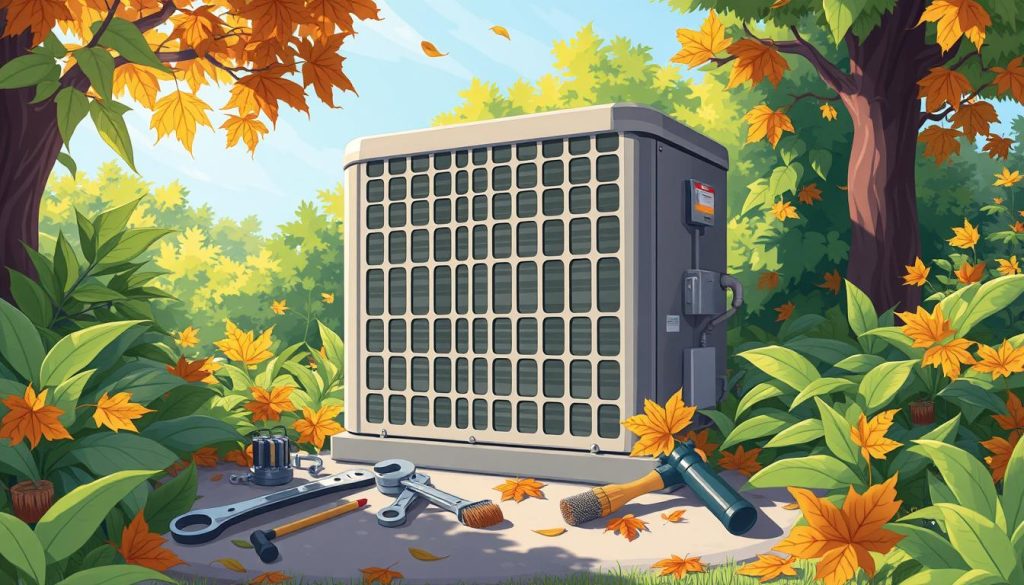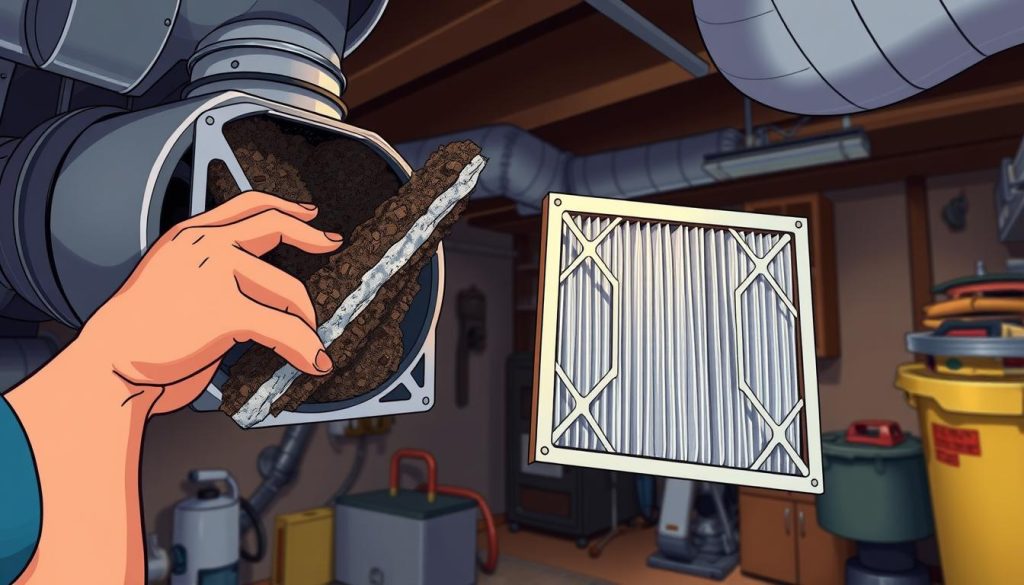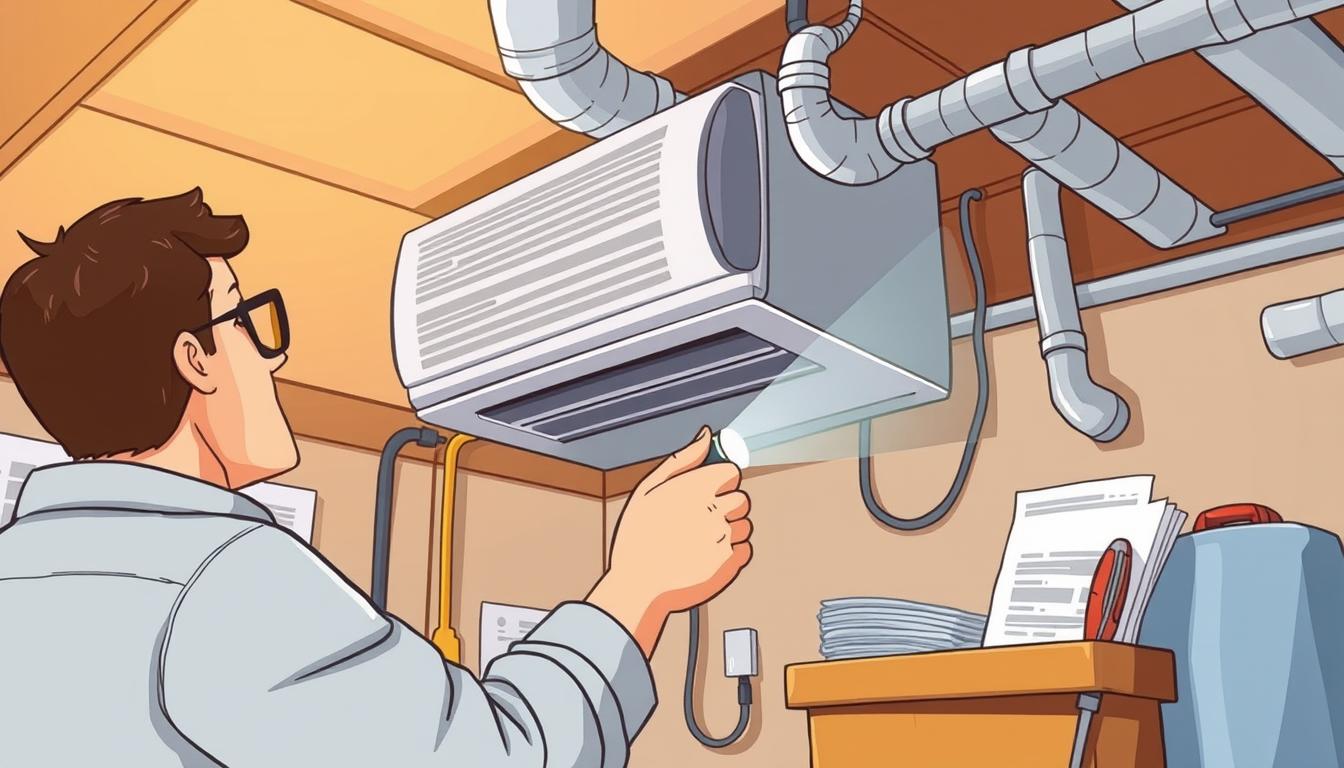Checking your HVAC system yourself can save money and keep it running well. It helps you spot problems early and keeps your home comfortable. This guide will show you how to do a DIY HVAC check. You’ll learn to check the thermostat, find issues, and know when to call a pro.
Key Takeaways
- Regular HVAC checks are key for saving energy, clean air, and a long-lasting system.
- Get ready for the inspection by turning off power and having the right tools.
- Check the thermostat, look at outdoor and indoor parts, and test how well it works.
- Watch out for odd sounds, smells, or if it’s not cooling or heating right. Know when to call a pro.
- Annual maintenance plans offer full HVAC care and support.
Understand the Importance of Regular HVAC Inspections
Regular HVAC inspections are key to keeping your home’s heating and cooling system running well. They help spot problems that can hurt the system’s energy efficiency. This ensures it works its best and saves you money on bills.
Maintain Energy Efficiency
A well-kept HVAC system uses less energy. This means lower bills for you each month. So, getting regular checks is a smart move.
Ensure Indoor Air Quality
A good HVAC system is vital for clean air inside your home. Regular checks and services keep the air clean and healthy. This is important for a comfy and safe living space.
Prolong System Lifespan
Regular checks and care can make your HVAC system last longer. This means you won’t have to replace it as often. It’s a way to get more value from your investment.
Knowing how important regular HVAC inspections are helps your system work better. It keeps the air clean and provides comfort for years.
| Benefit | Description |
|---|---|
| Energy Efficiency | A well-maintained HVAC system consumes less energy to heat and cool your home, leading to lower utility bills. |
| Indoor Air Quality | Regular HVAC inspections ensure proper air filtration and circulation, promoting a healthier living environment. |
| System Lifespan | Preventive maintenance can extend the lifespan of your HVAC system, helping you avoid costly replacements. |
Prepare for the Inspection Process
Before starting your HVAC self-inspection, it’s important to take safety steps. First, make sure to turn off the power to both indoor and outdoor HVAC units. This step prevents accidents and injuries during the inspection.
Turn Off Power Supply
Find the right breakers or switches for your HVAC system’s power. Then, turn them off. This makes sure the system is safe to inspect without the risk of electric shock.
Gather Essential HVAC DIY Tools and Supplies
- Screwdriver set
- Flashlight
- Level
- Coil cleaning solution
- Soft-bristle brush
- Rubber gloves
Having the right HVAC DIY tools and equipment makes the inspection easier. Make sure you have all the necessary items before starting your HVAC inspection preparation.
By following HVAC safety precautions and having the right tools, you’re ready for a successful HVAC self-inspection. This helps you find any problems and keeps your system working well.
Assess Thermostat Functionality
Start by checking your thermostat’s function before looking at other HVAC parts. This key device is vital for your home’s comfort and energy use.
Ensure Accurate Temperature Settings
First, make sure your thermostat is set to the right temperature. Check if the display matches the room’s actual temperature. If not, you might need to calibrate it to control your home’s heat or coolness.
Evaluate Thermostat Responsiveness
Then, test if your thermostat changes temperature well. Change the setpoint and see if the HVAC system works as it should. If it doesn’t, you might need to HVAC thermostat testing or calibration.
Inspect Smart Thermostat Features
If you have a smart thermostat, make sure it’s set up right. Check if it tracks temperature changes, follows schedules, and works with your home systems. Proper thermostat calibration is key for comfort and saving energy.
| Thermostat Feature | Functionality Check |
|---|---|
| Temperature Display | Verify that the displayed temperature matches the actual room temperature |
| Temperature Setpoint | Confirm that the thermostat is set to the desired temperature |
| System Response | Observe if the HVAC system turns on and off as expected based on temperature changes |
| Programmable Features | Ensure that pre-set schedules and smart home integrations are functioning correctly |
By doing a thorough HVAC thermostat testing, you can check your HVAC system’s health. This step helps find problems and ensures your system works well, saves energy, and keeps your home comfortable.
Inspect the Outdoor HVAC Unit
Keeping your outdoor HVAC unit in good shape is key for its performance and life. Start by checking the unit for any problems that need fixing.
Clear Debris and Obstructions
The outdoor HVAC unit faces the weather and gets dirty. First, take off the protective cage. Then, use a wet/dry vacuum to get rid of leaves, sticks, and other stuff from inside the unit.
Clean and Straighten Fins
Next, use a garden hose to clean the coils and fins. This will remove dirt and grime. But, don’t use a pressure washer because it can harm the fins. If fins are bent or broken, use a butter knife or a fin-straightening tool to fix them.
Check for Level Positioning
Lastly, make sure the outdoor unit is level. If not, use weather-resistant shims to balance it. A level unit works better and lasts longer.
| Task | Description |
|---|---|
| Clearing HVAC Debris | Remove leaves, sticks, and other obstructions from the interior of the outdoor HVAC unit using a wet/dry vacuum. |
| Cleaning HVAC Coils and Fins | Gently spray the coils and fins with a garden hose to remove dirt and grime, taking care not to use a pressure washer. |
| HVAC Unit Leveling | Check the level of the outdoor unit and use weather-resistant shims to ensure it is properly balanced. |

Examine the Indoor Components
After checking the outdoor HVAC unit, it’s time to look at the indoor parts. The indoor air handler or furnace is key for indoor HVAC unit maintenance. Let’s explore two important tasks to keep your system efficient.
Clean Evaporator Coil
Begin by opening the access panel to the indoor unit. Then, clean the evaporator coil. Use a evaporator coil cleaning solution to remove dust, debris, or buildup. This buildup can block airflow and lower your HVAC system’s efficiency.
Clear Evaporator Drain
Next, check the evaporator drain line for clogs or blockages. A clear drain line is vital to avoid water damage and ensure moisture drainage. Flush the drain with hot water, soap, and a bit of bleach to keep it clear and prevent future blockages.
| Task | Importance | Frequency |
|---|---|---|
| Evaporator Coil Cleaning | Improves airflow and efficiency | Annually or as needed |
| Evaporator Drain Maintenance | Prevents water damage and clogs | Annually or as needed |
By focusing on these two key indoor components, you’ll help keep your HVAC system running well. Stay tuned for the next steps in your self-inspection journey!
How to self inspect HVAC?
Regular self-inspections of your HVAC system are key to its performance and longevity. Focus on two main tasks: replacing air filters and lubricating moving parts.
Replace Air Filters
Dirtied or clogged air filters can block airflow. This makes your HVAC system less efficient and raises your energy bills. Replace the filters every 3 months as the manufacturer suggests. This simple step greatly improves your system’s performance.
Lubricate Moving Parts
Find the moving parts in your HVAC, like the blower motor. Add a bit of lubricant to keep them running smoothly. Proper HVAC motor lubrication extends their life and prevents damage. It’s a crucial part of DIY HVAC maintenance steps.
| Task | Frequency | Benefits |
|---|---|---|
| HVAC Air Filter Replacement | Every 3 months | Improved airflow, energy efficiency, and system performance |
| HVAC Motor Lubrication | As needed | Extended component lifespan and reduced wear and tear |
By regularly doing these DIY HVAC maintenance steps, you keep your system running well. This saves you money on energy and extends your system’s life. Always prioritize safety and seek a pro if unsure about your HVAC self-inspection.

Test System Operation
After you’ve finished inspecting and maintaining your HVAC system, it’s time to test it. Turn the power back on and use the thermostat to cycle the system. Make sure it works well in both heating and cooling modes.
If you hear strange noises or notice inadequate cooling or heating, take note. A lack of airflow is also a sign of trouble. If you find any issues, it’s best to call a professional HVAC technician for HVAC troubleshooting.
Proper HVAC system performance testing is key. It ensures your system works efficiently and helps spot problems early.
Step-by-Step Guide to Testing HVAC System Operation
- Restore power to the HVAC system and turn on the thermostat.
- Set the thermostat to cooling mode and lower the temperature setting by a few degrees.
- Listen for the outdoor unit to start up and feel the airflow from the indoor vents.
- Repeat the process, this time setting the thermostat to heating mode and raising the temperature.
- Observe the system’s response, ensuring it’s providing the expected heating or cooling performance.
- Note any unusual sounds, such as rattling, grinding, or loud operation.
- Check for adequate airflow from the vents and even distribution throughout the home.
- If you encounter any issues, refer to your DIY HVAC inspection checklist and consider calling a professional for further assistance.
Testing your HVAC system’s operation is vital. It ensures your system stays efficient and reliable. By following these steps, you can find and fix any problems, keeping your system in top shape.
Identify Potential Issues
When you start checking your HVAC, look out for any signs of trouble. Strange noises, odd smells, and not enough cooling or heating are warning signs. These could mean there’s a problem with your heating, ventilation, and air conditioning system.
Listen for Strange Noises
Listen carefully for any odd sounds from your HVAC. Grinding, banging, or too much vibration might mean trouble. It could be with the compressor, blower motor, or other important parts. Don’t ignore these sounds, as they could mean a bigger issue.
Be Aware of Unusual Odors
Strange smells coming from your HVAC system could also mean trouble. Electrical problems or a refrigerant leak might cause these smells. If you smell something odd, find out where it’s coming from right away.
Identify Inadequate Cooling or Heating
If your home isn’t getting the right temperature, it might be a sign of a bigger problem. This could be because of a refrigerant issue, a faulty thermostat, or ductwork problems. Fixing these early can save you from bigger and more expensive repairs later.
By being careful and attentive during your HVAC check, you can spot HVAC troubleshooting signs. You can also tackle common HVAC problems and HVAC system issues to watch for before they get worse. Taking care of your HVAC early can help it work better and longer.
Consider Professional Assistance
Doing a DIY HVAC check is good for keeping your system in shape. But, some jobs are better for pros. If you find big problems like HVAC repair or HVAC replacement, get a pro.
Think about getting an HVAC maintenance plan too. It offers regular checks, fast service, and repair discounts. This keeps your system running well, so you don’t have to stress about when to call a technician.
Complex Repairs or Replacements
Some HVAC problems need a pro’s touch, like refrigerant leaks or compressor failures. Trying to fix these yourself can be risky and might make things worse. It’s safer and smarter to let experts handle these jobs.
Annual Maintenance Agreements
Getting an HVAC maintenance plan is a wise move. It includes regular checks, new filters, and fast service if needed. Keeping up with maintenance stops big problems and keeps your system efficient, saving you money and energy.
Conclusion
Checking your HVAC system yourself is a smart and affordable way to keep your home comfortable. By following the steps in this guide, you can spot problems early and make your system work better. This helps keep your home safe and cozy.
Regular checks of your HVAC system have many advantages. You can boost your HVAC self-inspection summary, get more from DIY HVAC maintenance benefits, and see why professional HVAC service is key. Finding the right mix of self-checks and expert help keeps your system running smoothly and saving energy.
Whether you own or rent your home, knowing how to care for your HVAC system is crucial. It can save you money, make the air cleaner, and make your equipment last longer. With the tips and tools from this guide, you’re ready to be your own HVAC expert. This way, you can keep your home comfy and energy-wise all year.





0 Comments